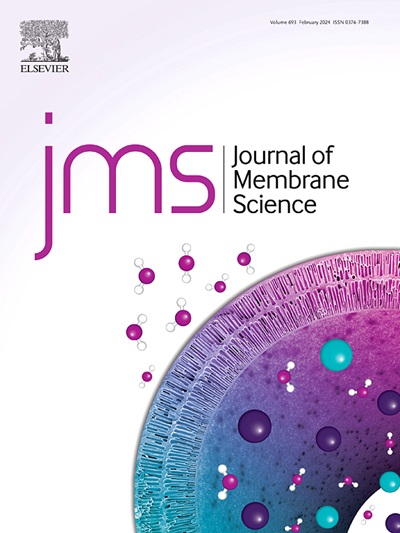Micro-nano bubbles enhance the Fe(II)/persulfate process for ultrafiltration membrane fouling control: Performance and mechanisms
IF 9
1区 工程技术
Q1 ENGINEERING, CHEMICAL
引用次数: 0
Abstract
The persistent challenges of membrane fouling and insufficient removal of emerging pollutants remain significant barriers to the widespread adoption of ultrafiltration processes. Therefore, a pre-oxidation system combining Fe(II)-activated persulfate with micro-nano bubble enhancement (MBs/Fe(II)/PS) was developed to alleviate membrane fouling and efficiently remove acetochlor (AC). The results demonstrated that, under conditions where Fe(II) and persulfate (PS) were applied at concentrations of 15 μM and 30 μM respectively, the MBs/Fe(II)/PS pre-oxidation system outperformed the Fe(II)/PS pre-oxidation system in mitigating both reversible and irreversible membrane fouling caused by natural organic matter (NOM) mixture. The superior fouling mitigation capabilities of the MBs/Fe(II)/PS system can be primarily attributed to the coagulation effect of in-situ generated Fe(III) and the oxidation mechanisms involving free radicals. Furthermore, the MBs/Fe(II)/PS pre-oxidation process effectively reduced foulant accumulation on the membrane surface while decreasing interfacial free energy between foulants and the membrane. This transition facilitated a shift from cake filtration to complete blocking or intermediate blocking modes. Additionally, the MBs/Fe(II)/PS pre-oxidation system exhibited optimal performance in degrading NOM and AC due to the presence of SO4•–, •OH, and 1O2. This study introduces a novel pre-oxidation strategy for mitigating membrane fouling and eliminating emerging pollutants, providing a theoretical basis for the practical application of MBs-based pre-oxidation technology.

微纳气泡增强Fe(II)/过硫酸盐工艺对超滤膜污染的控制:性能和机理
膜污染的持续挑战和对新出现污染物的去除不足仍然是超滤工艺广泛采用的重大障碍。为此,研究了Fe(II)活化过硫酸盐与微纳泡增强剂(mb /Fe(II)/PS)相结合的预氧化体系,以缓解膜污染并有效去除乙草胺(AC)。结果表明,当Fe(II)和过硫酸盐(PS)的浓度分别为15 μM和30 μM时,mb /Fe(II)/PS预氧化体系在减轻天然有机物(NOM)混合物引起的可逆和不可逆膜污染方面均优于Fe(II)/PS预氧化体系。MBs/Fe(II)/PS体系的优异缓污能力主要归因于原位生成的Fe(III)的混凝作用和自由基氧化机制。此外,MBs/Fe(II)/PS预氧化工艺有效地减少了污染物在膜表面的积累,同时降低了污染物与膜之间的界面自由能。这种转变促进了从滤饼过滤到完全阻塞或中间阻塞模式的转变。此外,由于SO4•-、•OH和1O2的存在,MBs/Fe(II)/PS预氧化体系在降解NOM和AC方面表现出最佳性能。本研究介绍了一种新型的预氧化策略,用于减轻膜污染和消除新出现的污染物,为基于mbs的预氧化技术的实际应用提供了理论依据。
本文章由计算机程序翻译,如有差异,请以英文原文为准。
求助全文
约1分钟内获得全文
求助全文
来源期刊

Journal of Membrane Science
工程技术-高分子科学
CiteScore
17.10
自引率
17.90%
发文量
1031
审稿时长
2.5 months
期刊介绍:
The Journal of Membrane Science is a publication that focuses on membrane systems and is aimed at academic and industrial chemists, chemical engineers, materials scientists, and membranologists. It publishes original research and reviews on various aspects of membrane transport, membrane formation/structure, fouling, module/process design, and processes/applications. The journal primarily focuses on the structure, function, and performance of non-biological membranes but also includes papers that relate to biological membranes. The Journal of Membrane Science publishes Full Text Papers, State-of-the-Art Reviews, Letters to the Editor, and Perspectives.
 求助内容:
求助内容: 应助结果提醒方式:
应助结果提醒方式:


